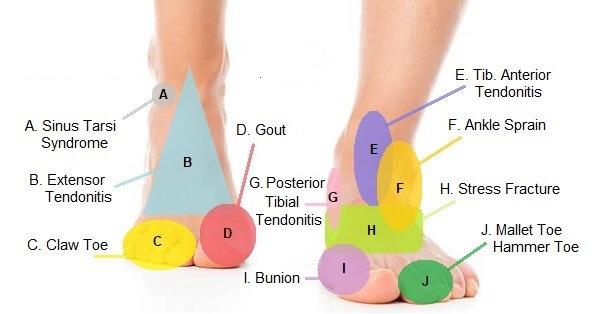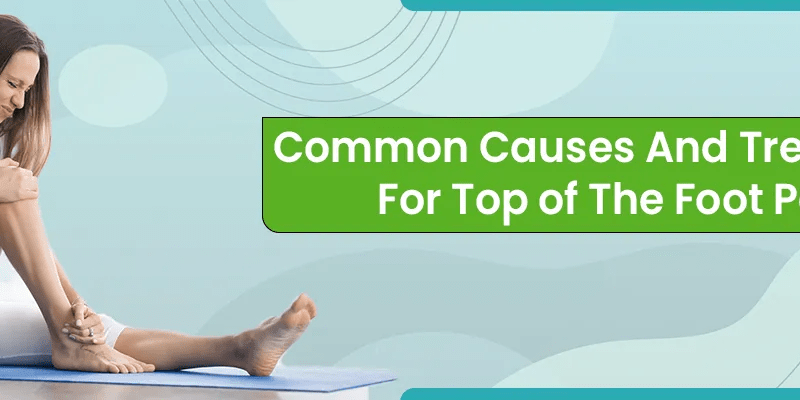The foot consists of a complex system of bones, joints, muscles, ligaments, and tendons to function properly and sustain everyday actions like walking and standing.
However, a variety of health disorders and accidents can disrupt the foot’s movement and balance, resulting in pain and discomfort.
Pain on the top of the foot may appear odd, especially if there has been no apparent injury. Other than a bone fracture or bruise, this area can be impacted by several problems and traumas.
Dr. Sandeep Singh, a prominent orthopedic doctor in Bhubaneswar, says, “Though pain in the top of the foot may appear uncommon, it is a regular condition seen by an orthopedic surgeon.”
He is the HOD of Sports Injury and Rehabilitation at Care Super Specialty Hospital. He is an expert in hip replacement, knee replacement, arthroscopic surgery, limb reconstruction, fractures, and foot and heel pain.
You surely must be wondering what causes pain on the top of the foot?

The following are some of the side effects of excessive use:
Extensor tendonitis –
This condition occurs due to muscle tightness, flat feet, prolonged walking or standing, or wearing tight shoes. Pain and inflammation develop in the tendons that extend along the top of the foot that lifts the toes.
Stress fractures in the feet:
Fractures in the bones on the top of the feet called metatarsal bones can occur due to repetitive overloading. The fracture causes severe pain and swelling.
Sinus tarsi syndrome –
This uncommon condition is indicated by an inflamed sinus tarsus, a tract that runs between the heel and the ankle bone. It causes instability, ankle stiffness, and pain on the top of the foot and the outside of the ankle.
Gout-
It is a type of inflammatory arthritis that causes severe pain in the joint at the base of the big toe. High levels of uric acid form crystals in the joint that causes swelling, redness, and heat.
Peripheral neuropathy –
Due to this condition, you will feel numbness, pain, or prickling on the feet that radiates upwards towards the legs.
Bone spurs –
They are painful growths that develop in your feet joints near the toes.
Peroneal nerve dysfunction –
- This condition occurs due to the malfunction of the sciatic nerve branch that causes pain and tingling at the top of the foot as well as weakness of the lower leg or foot.
- If you have been suffering from any of the above conditions for more than a week, you should consult Dr. Sandeep Singh, an orthopedist in Bhubaneswar. He is well-versed in diagnosing and treating all the injuries and disorders related to the bones, ligaments, joints, and tendons.
How is the pain diagnosed?
The doctor will examine your foot and press at different areas to see the pain. They may further ask you to do some exercise and walk to see the range of motion.
You will have to undergo tests, which may include:
MRI to check the peroneal nerve for damage.
Blood tests to verify gout.
X-ray if your doctor doubts a fracture, broken bone, or a bone spur.
Ways in which the pain on top of the foot is treated?

Treatment options for foot pain differ based on the underlying condition. Below are some of the treatment options for the top of the foot pain.
RICE method
Rest, Ice, Compression, and Elevation (REST) is the first thing you should do when you experience pain. Rest will allow the injury to heal correctly and, in the meantime, avoid doing the activity that caused it.
You can reduce both pain and inflammation with regular cooling and compression. Also, elevating the foot helps.
Anti-inflammatory medications
NSAIDs help in reducing inflammation and pain. Steroid injections are administered to decrease stiffness and swelling in certain conditions.
Shockwave therapy
This therapy sends impulse pressure waves to injured soft tissues to help them heal faster. The pressure waves increase the blood flow to the injured area, decreasing pain and inflammation. It is an effective method for quicker healing and recovery.
Physical therapy
Physical therapy helps to strengthen tendons and muscles and also increases flexibility. It is a crucial treatment modality that helps increase the range of motion and prevents further injury after recovery.
Cast
In case of a fracture or a broken bone, your orthopedic doctor will put a cast on your injury to immobilize the bone and help in speedy recovery.
You may need surgery only in severe cases that do not improve after the above treatment, which is quite rare.
Outlook
It is vital to take care of your feet as any injury can restrict your mobility. Wearing comfortable and appropriate shoes can help protect the feet and reduce the risk of future injury.
However, always seek prompt treatment if you experience any pain and swelling on the top, heels, or beneath the feet. You can visit Dr. Sandeep Singh, a leading ortho doctor in Bhubaneswar, for accurate diagnosis and timely treatment.

